
If the GoT trailer were Getty manuscripts
Death. Torture. Violence. Dogma. Dragons. Vendetta. Blindness. Walking dead.
The long-awaited sixth season of Game of Thrones has arrived, and as we did for the last two seasons we’ll be recapping each week’s episode with medieval art. For the series’ ten weeks, journey with us through the pages of illuminated manuscripts that could just as easily be screenshots from HBO.
This year two of us manuscripts curators are teaming up to focus on new themes. Last season we explored medievalisms in Game of Thrones, but now we’ll look at at book arts from the global Middle Ages through a Hollywood lens, considering medieval parallels to today’s screenwriting, costume design, lighting, special effects, music, and art direction. We hope we’re equal to the task: One of us (Alex) grew up on set and has loved medieval history and fantasy since girlhood; the other (Bryan) traces his trajectory of fascination for the medieval to childhood days playing Zelda II: The Adventures of Link on NES. Oh, and he speaks and reads Elvish. See our bio for full nerd credentials.
This post will grow each week of season six as we explore parchment–pixel parallels, with lots of juicy details from two of our current favorite medieval things here at the Getty:
- Medieval globalisms—Delve with us into objects and themes in the exhibition Traversing the Globe through Illuminated Manuscripts (through June 26), which explores worldwide artistic, cultural, and religious connections of the Middle Ages.
- Knightly adventure—We’ll transport you from courtly stability to turbulent battlefields in true G.R.R. Martin style with the Museum’s newly acquired Renaissance manuscript, Book of the Deeds of Jacques de Lalaing.
Parchment to Pixels Featurettes

Saint Bellinus Celebrating Mass, about 1469, Taddeo Crivelli, J. Paul Getty Museum. Ms. Ludwig IX 13
DIRECTING
Directors are responsible for organizing cast members and crew in visualizing and dramatizing a script.
Similarly, manuscript production required the skills of numerous specializations, from the scribe to the illuminators and book binders, often under the direction of a patron (whose financial contributions to the project also mirror that of a modern-day producer).
The patrons of this prayer book, military leader Andrea Gualengo and noblewoman Orsina d’Este, appear with two sons kneeling before a local saint from Ferrara, Bellinus, who celebrates Mass in a private chapel setting.
Evidence of their patronage can be seen elsewhere in the manuscript, through Latin mottoes, coats of arms, and symbols of rulership. The artists Taddeo Crivelli and Guglielmo Giraldi were contracted to complete the numerous illuminations of saints and the Virgin Mary. The patrons likely chose these scenes and the related prayers for their personal devotion.

Christ Before Herod, about 1480-1490, J. Paul Getty Museum, Ms. 101
EDITING
Editing is perhaps the most quintessential element for clear, tight, and engaging storytelling, whether on parchment pages or through the pixels of television.
This Vita Christi (Life of Christ) manuscript began as a devotional picture book with no text (circa 1190), much like a storyboard. A second cycle of images and prayers were added in the late 1400s and integrated into the earlier cycle — a rough cut.
At this point the transformed book now presented its reader with a complete picture of Christian spiritual history, from Eden to the Last Judgement, along with a few additional devotional memory devices along the way (in the form of rosaries). Today, art historians grapple with understanding the final, or edited, version.

Initial C: David Playing Bells; Master of the Ingeborg Psalter, after 1205, J. Paul Getty Museum, Ms. 66
MUSIC
From joyful melodies to moments of suspense, music is a universal language that communicates emotion. In the medieval period, music can be divided into two categories: secular and liturgical. One type of liturgical manuscript is the choir book. Produced for use during church services there are various kinds including breviaries, antiphonals, graduals, and missals. These had to be large enough so that all the members of a monastic choir could view the open page at the same time.
The Old Testament (Hebrew Bible) recounts how King David led musical rituals during the installation of the Ark of the Covenant. He is also credited with writing many of the Psalms and his musicality is often expressed through images which show him playing a harp or bells, as in this historiated initial C for Psalm 87.
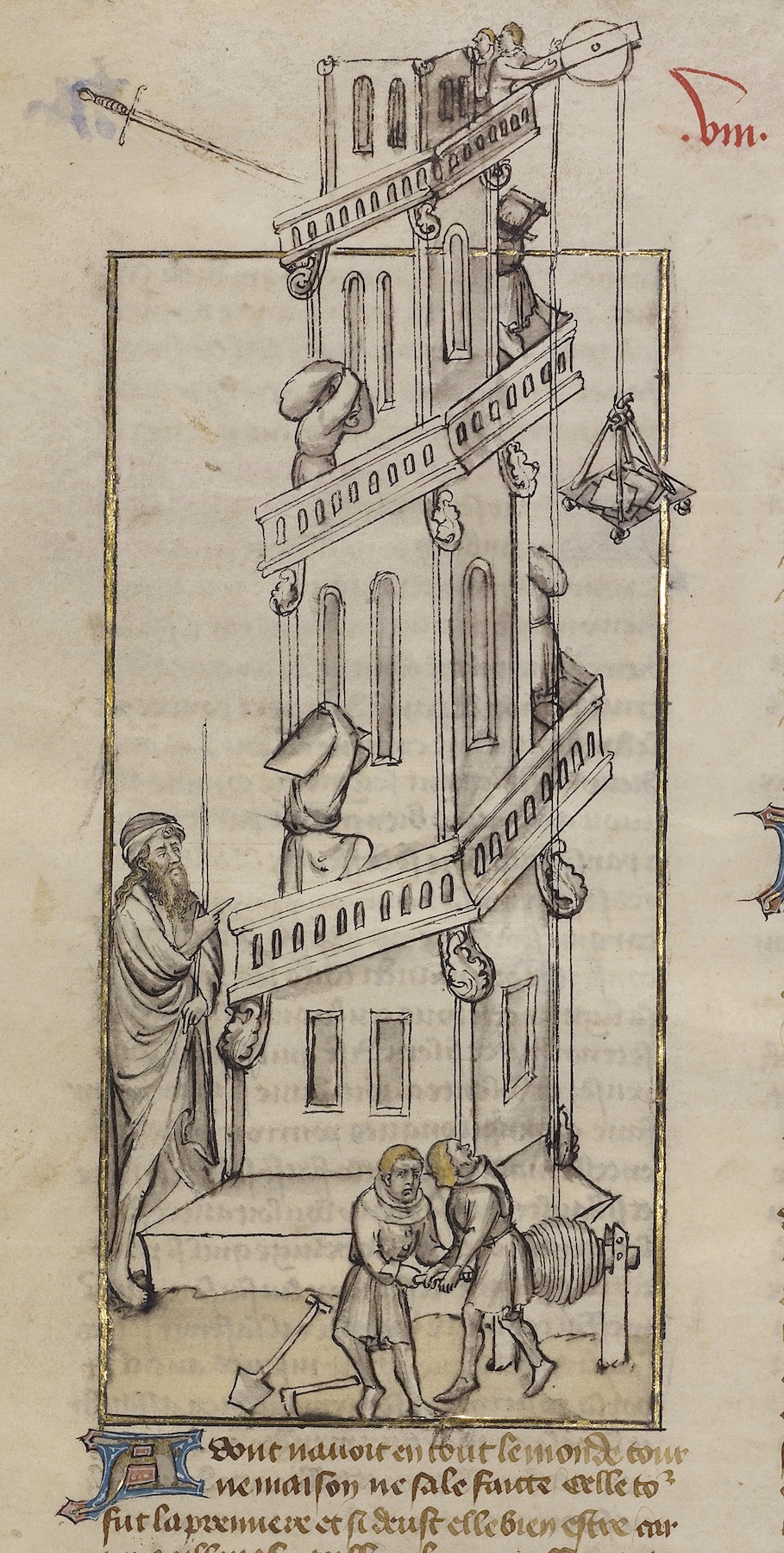
The Building of the Tower of Babel; First Master of the Bible historiale of Jean de Berry, about 1390 – 1400, J. Paul Getty Museum, Ms. Ludwig XIII 3
PRODUCTION DESIGN
A visual environment helps bring a story to life.
In film, the Art Department is responsible for designing and constructing the physical worlds actors inhabit. Centuries earlier, in this illumination, a tower is constructed with medieval technologies in a contemporaneous architectural style that would have seemed familiar to a fifteenth-century viewer.
The story of the Tower of Babel from the Hebrew Bible (Old Testament) tells a moral about all the peoples of the earth sharing a common language. The Babylonians, however, endeavored to build a tower so tall that it would stretch to the heavens, which displeased God.
As punishment and to stop the construction of the tower God endows the builders with various languages so that they cannot communicate and scatters them across the earth.
From the left a frightening sword symbolizes God’s wrath and the impending disruption of the building project.
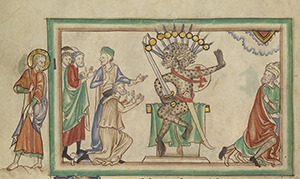
The Beast Enthroned, London (probably), about 1255 – 1260, J. Paul Getty Museum, Ms. Ludwig III 1
MONTAGE AND FLASHBACK
The Apocalypse (the Book of Revelations), or St. John’s visions of the end of days, is a central text in Christian theology. From the Island of Patmos John writes letters to the Seven Churches of Asia recalling his visions of the end of time. Fears of the end of days spurred by political turmoil, disease, and religious conviction, resulted in the popularization of Apocalypse manuscripts. In the Getty Apocalypse a portrait of John is incorporated into each miniature to guide the reader through a montage of terrifying events. Here the many-faced beast sits on a throne wielding a sword and casting blasphemies against God. On the right the faithful turn away from the monster while on the left its followers kneel in admiration.
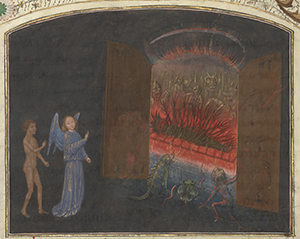
The Gates of Hell and Lucifer, 1475, Simon Marmion, The J. Paul Getty Museum, Ms. 30
SPECIAL EFFECTS
It takes teams of artists to create the impossible for the silver screen, but “special effects” for medieval painters meant bringing visions to life with nothing more than their brush and pigments. The Visions of the Knight Tondal was a popular moralizing tale. In it a sinful knight sees the virtues of piety after his soul journeys through the depths of Hell and into Paradise. Originally written in the twelfth century, it was copied and translated for hundreds of years after.
The Getty’s version, commissioned for Burgundian duchess and wife of Charles the Bold, Margaret of York (1446–1503), is the only extant illustrated version of this text. Here the illuminator Simon Marmion used vibrant pigments to intensify the fires burning just beyond the gates of Hell. Through the flames Tondal sees Lucifer squeezing souls of the damned with his ten thousand hands, as demons watch on.

A Scribe and a Woman, about 1400-1410, The J. Paul Getty Museum, Ms. 33
SCREENWRITING & DIALOGUE
Medieval authors and scribes are often faced with distilling massive amounts of text, history, and dialogue some ways akin to modern screenwriters faced with adapting literary works.
Rudolf von Ems (about 1200-1254), for example, was an epic poet whose Chronicle of World History drew inspiration from the Hebrew and Christian Bibles, as well as from Greek, Roman, and contemporaneous missionary accounts of the distant and recent past.
In the early fifteenth century, a scribe in Regensburg (Bavaria, Germany)—pictured at left sitting at a writing desk—copied the text for a noble patron (possibly the woman in black, whose instructions to the writer are imagined as speech banderoles).
Space was left for the illuminator, an unknown German artist who excelled at narrative scenes that depicted the juiciest passages. About eighty years later (in 1487), the manuscript entered the collection of Duke Albrecht IV the wise and his consort, Archduchess Kunigunde of Austria, whose portraits were added as a facing image and certain illuminations may have been censored at that stage.

An Emperor at Court, about 1460-1470, The J. Paul Getty Museum, Ms. 68
COSTUME
Clothing defines and distinguishes places and peoples. From the silhouette of a garment to subtle embroidery patterns or a characteristic headdress, fashion can derive inspiration from geography, climate, available materials, trade commodities, and regional crafts.
The humanist writer Aeneas Silvias Piccolomini (1405-1464)—who eventually became Pope Pius II—wrote lengthy snarky accounts about fashion, rituals, and ceremonies at court in On the Miseries of Courtiers, based largely on his service to Holy Roman Emperor Frederick III.
“A long train of servants followed the Emperor, and his clothes were stamped with gold, dyed with the Tyrian purple, woven of the thread that is spun in farthest China,” wrote Piccolomini of the ruler’s prized luxury fabrics.
The costume designer Michelle Clapton recently spoke at the Getty about her inspirations and work on Game of Thrones. Full video of the event is on YouTube.
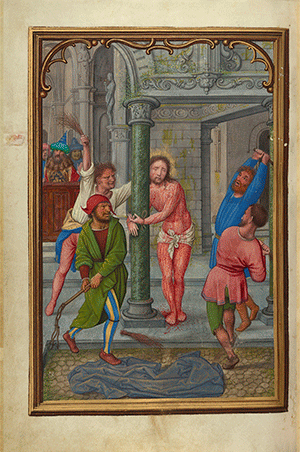
Four illuminations from the Prayer Book of Cardinal Albrecht of Brandenburg, about 1525–30, Simon Bening, J. Paul Getty Museum, Ms. Ludwig IX 19
SUSPENSE
Turning the pages of an illuminated manuscript can be a very personal experience, one that is often filled with tantalizing surprises from miniature to margin.
Medieval devotion emphasized visualizing oneself at various points throughout Christ’s life as a way to increase an emotional connection to past events and achieve deeper and more meaningful prayers in the present.
Simon Bening illuminated this personal prayer book for the powerful Cardinal Albrecht of Brandenburg, and through a series of richly painted miniatures, he brings Christ’s Passion vividly to the forefront of the viewer’s space.
Beaten and bloodied, publicly humiliated, crucified…with each turn of the page a reader would see Christ’s suffering increase until finally culminating in his resurrection.

Initial I: A Martyr Saint, third quarter of 14th century, Lippo Vanni, J. Paul Getty Museum, Ms. 53
COLOR PALETTE
Cinematographers can utilize color combinations to evoke specific moods or emotional responses. A complimentary color scheme of icy blues and warm earth tones opened up the newest cinematic chapter of A Song of Ice and Fire. Orange, gold, and blue were not only the leitmotif chosen for the first episode of season six, but is also the color palette of the Getty’s cutting Initial I: A Martyr Saint. Historiated initials indicate the beginning of an important section of text, although this one was removed from its original context (a choir book) over a century ago.
Shown with attributes of various martyrs—sword, palm of martyrdom, rocks for Saint Stephen, wool comb for Saint Blasius, or fire and grill for Saint Lawrence—medieval devotees could change this saint’s identity depending on their spiritual needs.
_______
On Wednesday, May 4 at 7:00 pm, a conversation with GoT costume designer Michelle Clapton happened to discuss the medievalisms behind the sumptuous looks she imagined for the show’s first five seasons.
_______
Season 6 Episode Recap Guide
Episode 1: The Red Woman
Episode 2: Home
Episode 3: Oathbreaker
Episode 4: Book of the Stranger
Episode 5: The Door
Episode 6: Blood of My Blood
Episode 7: The Broken Man
Episode 8: No One
Episode 9: Battle of the Bastards
Episode 10: The Winds of Winter


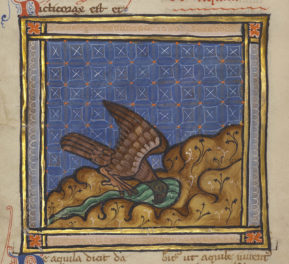
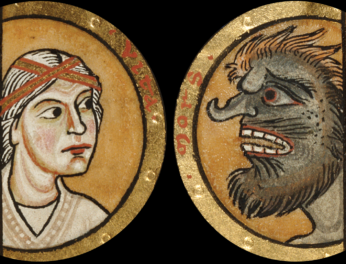
Comments on this post are now closed.